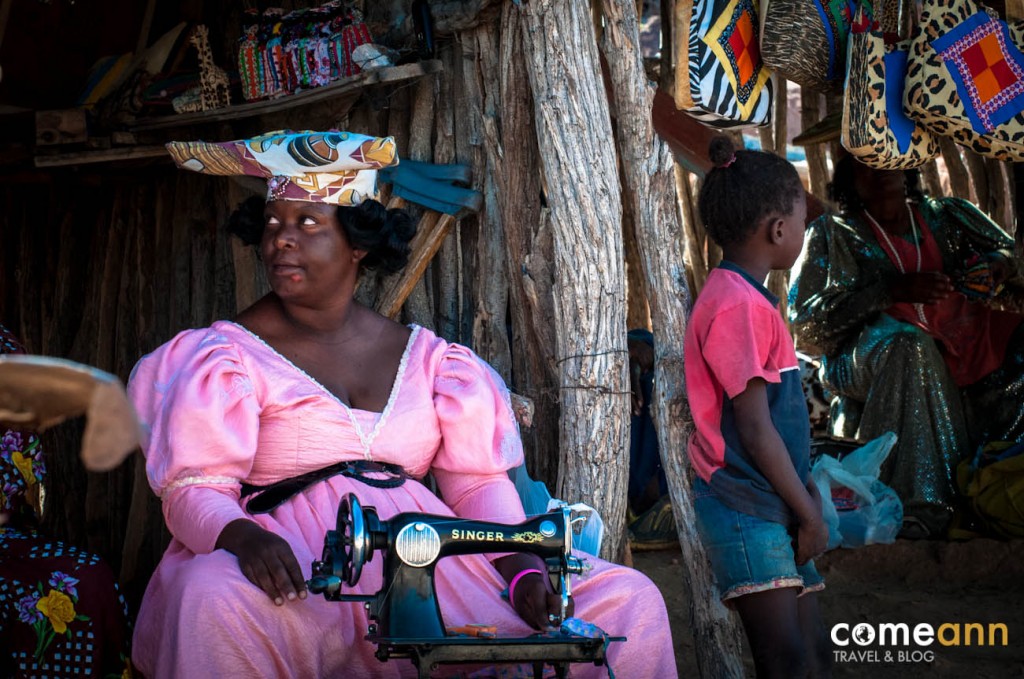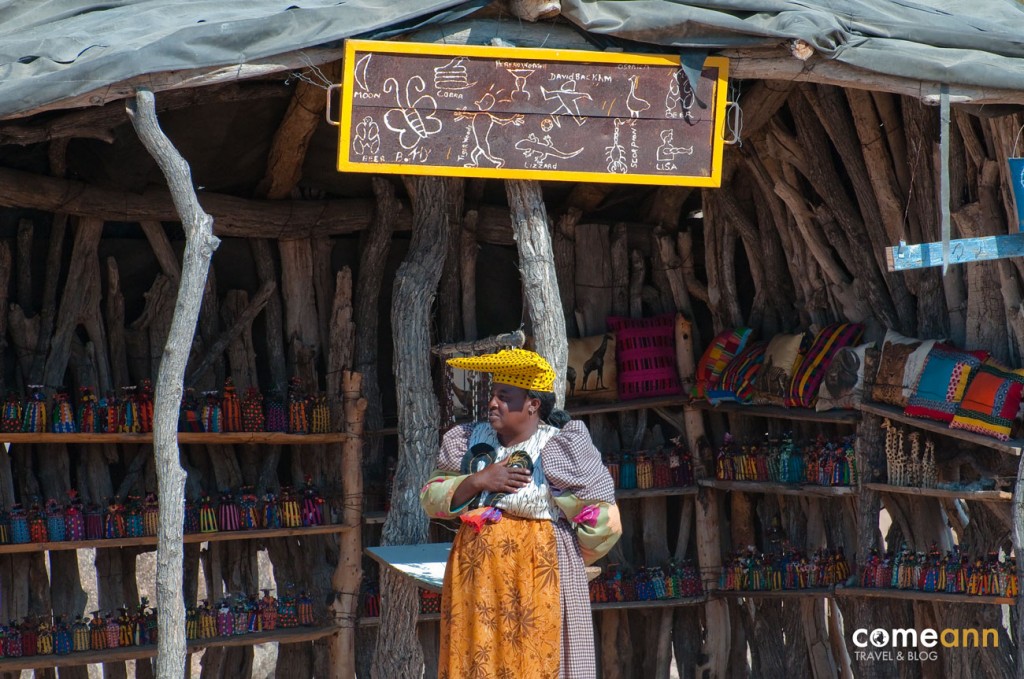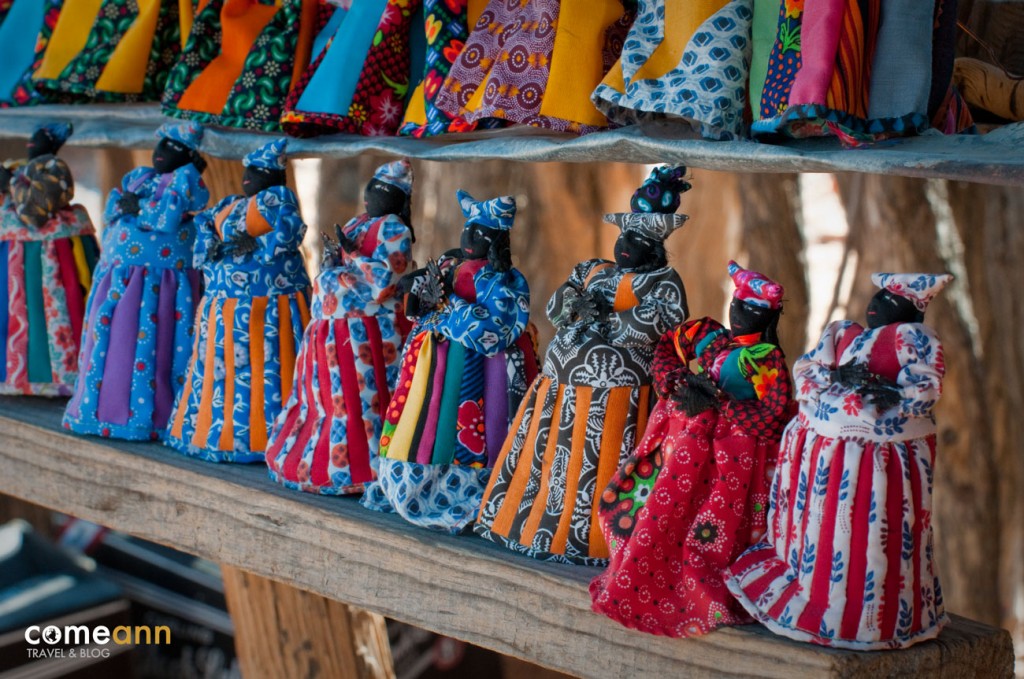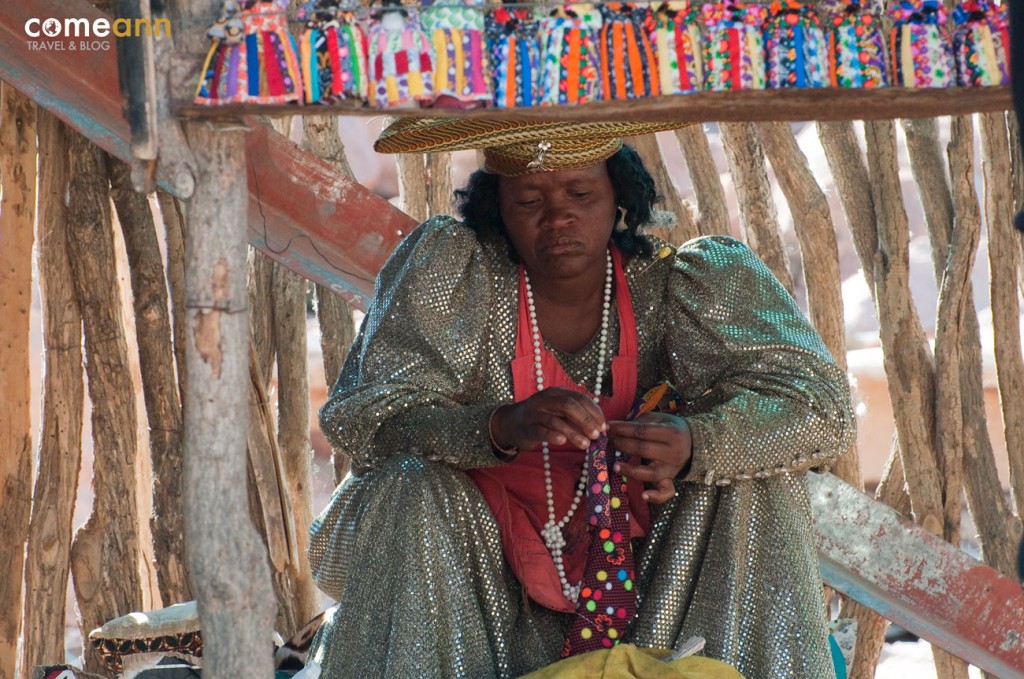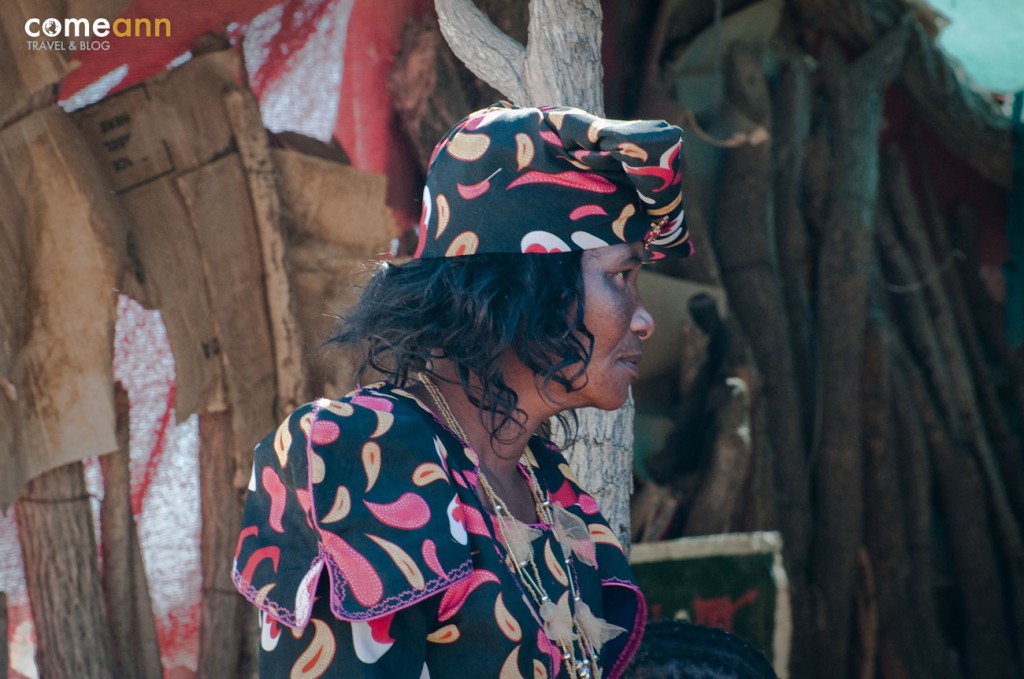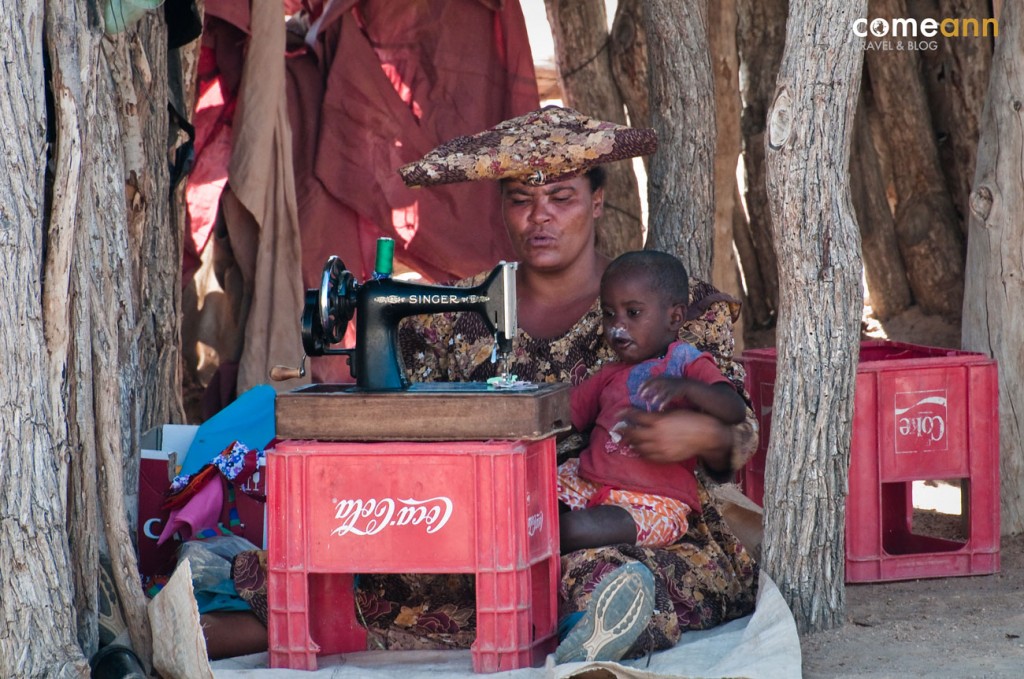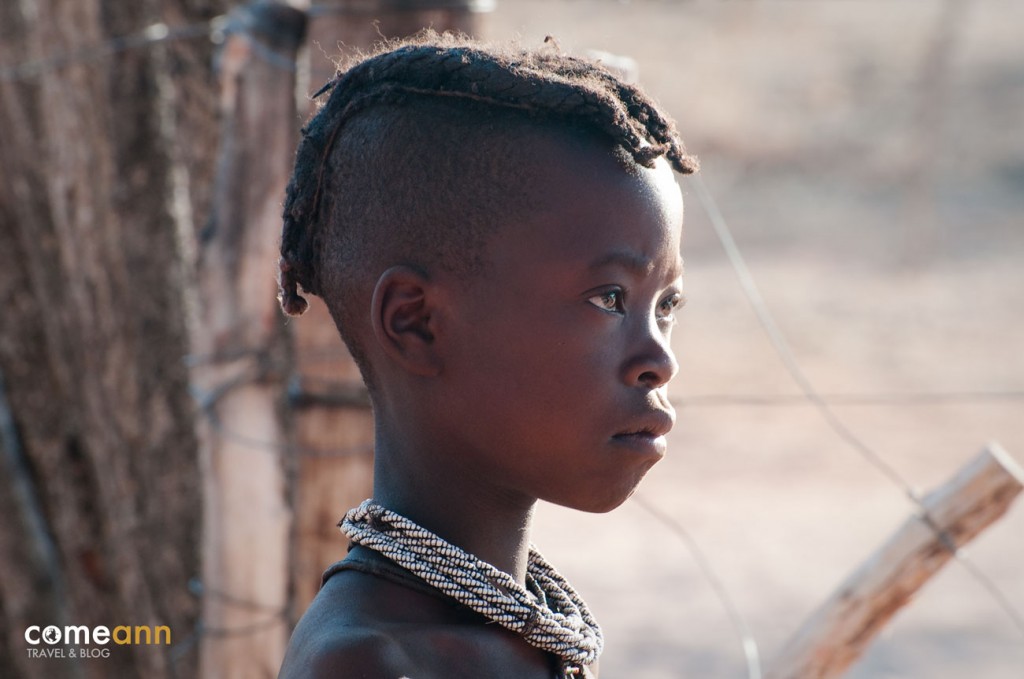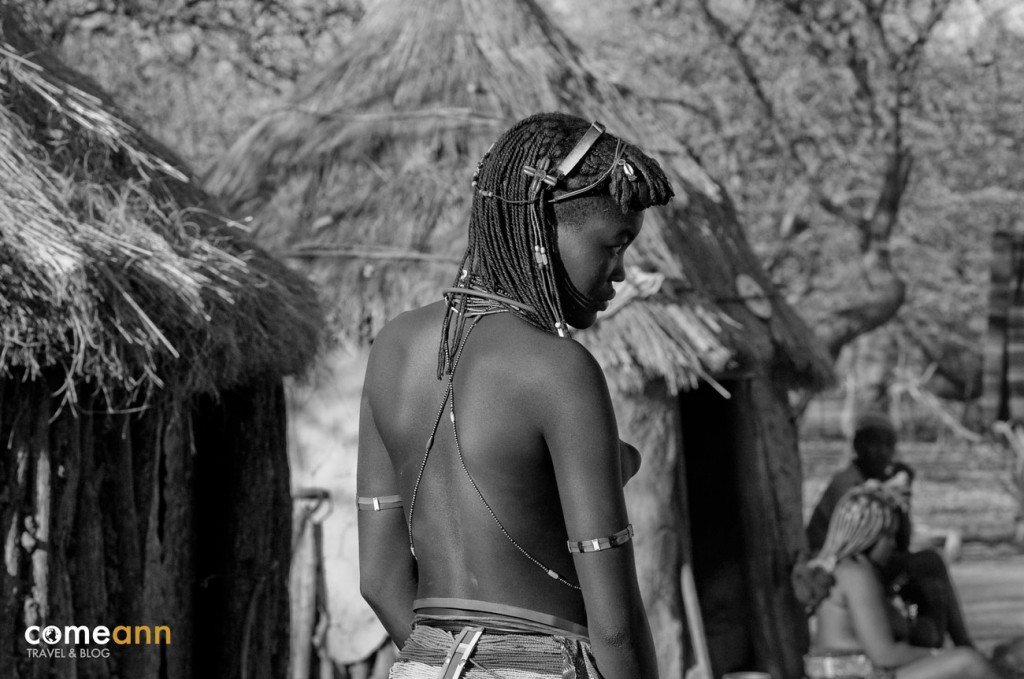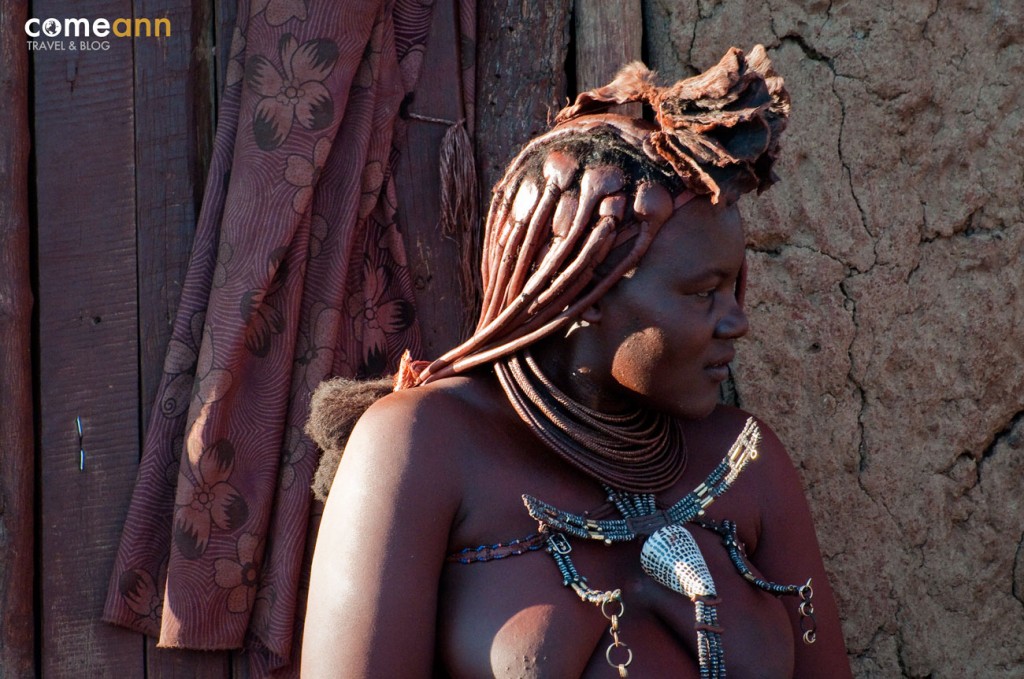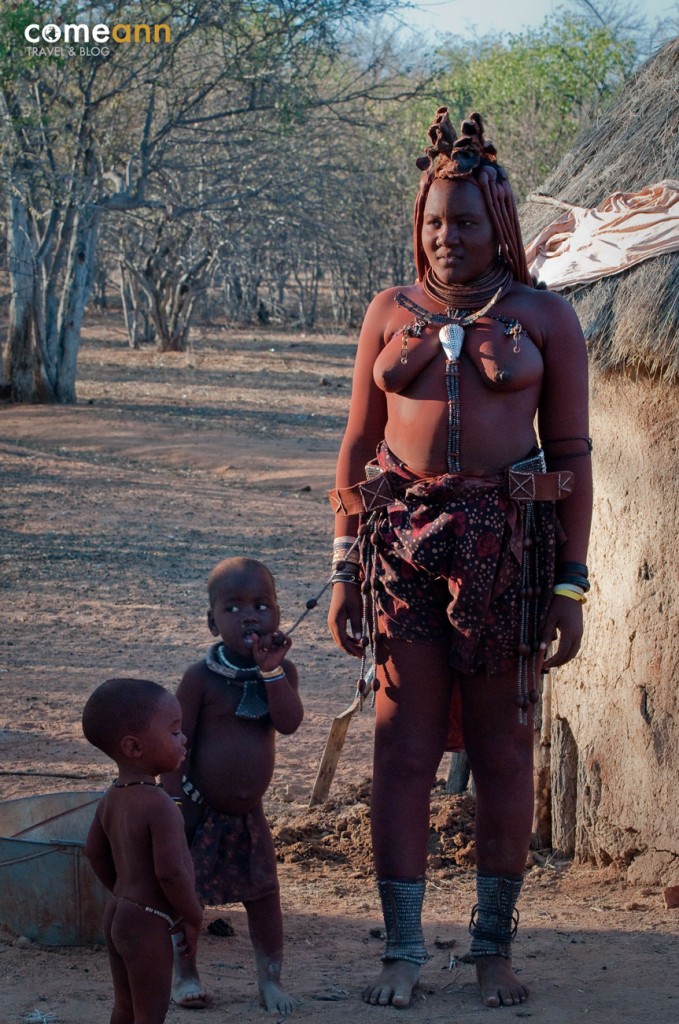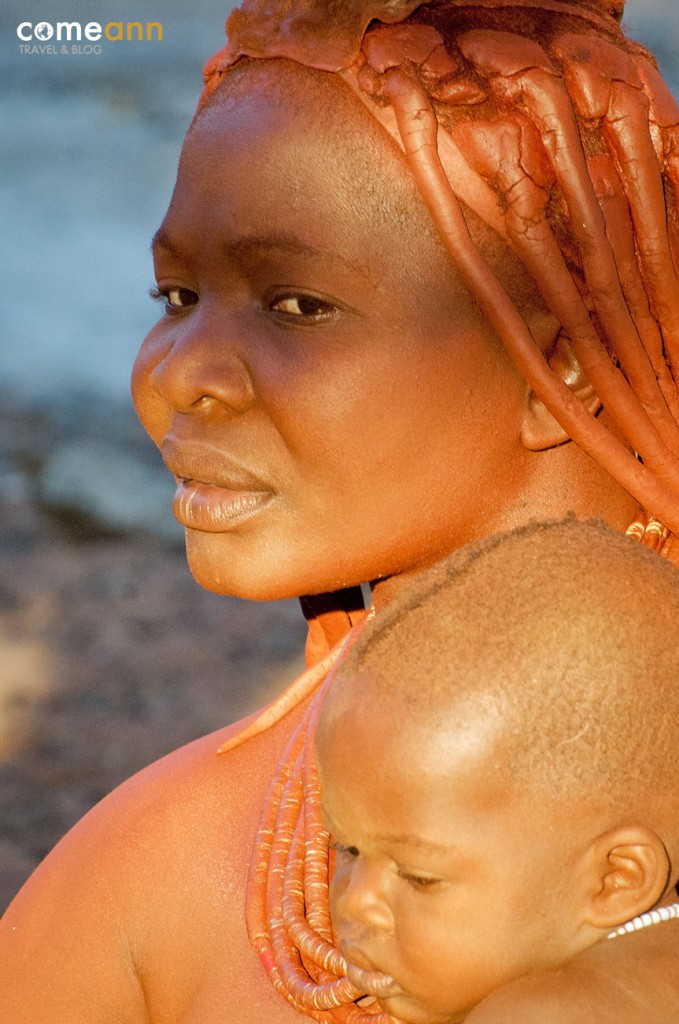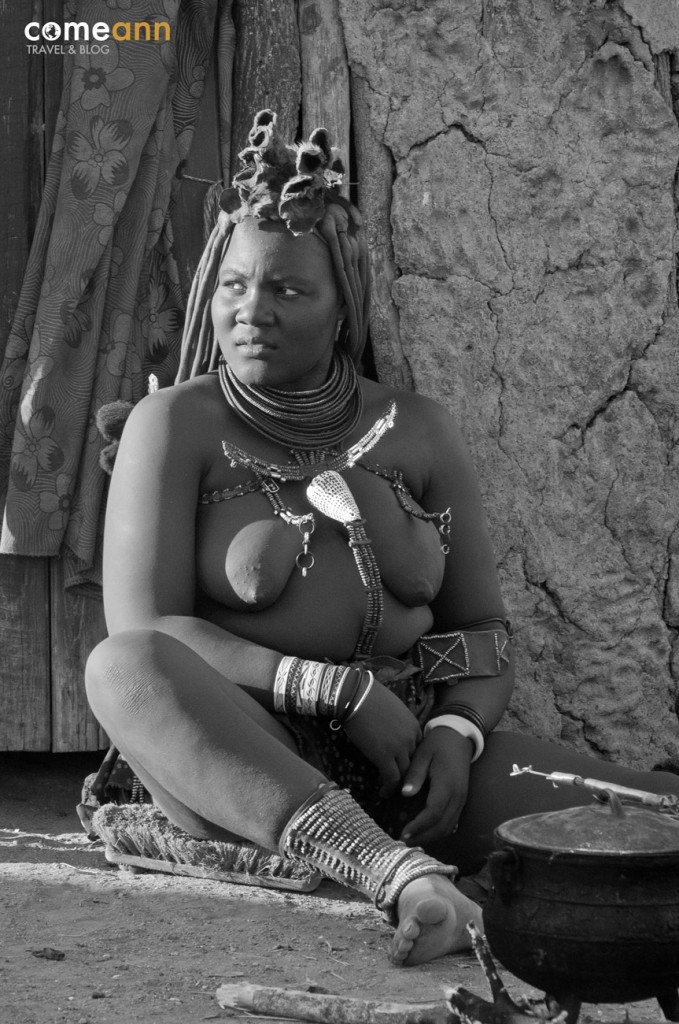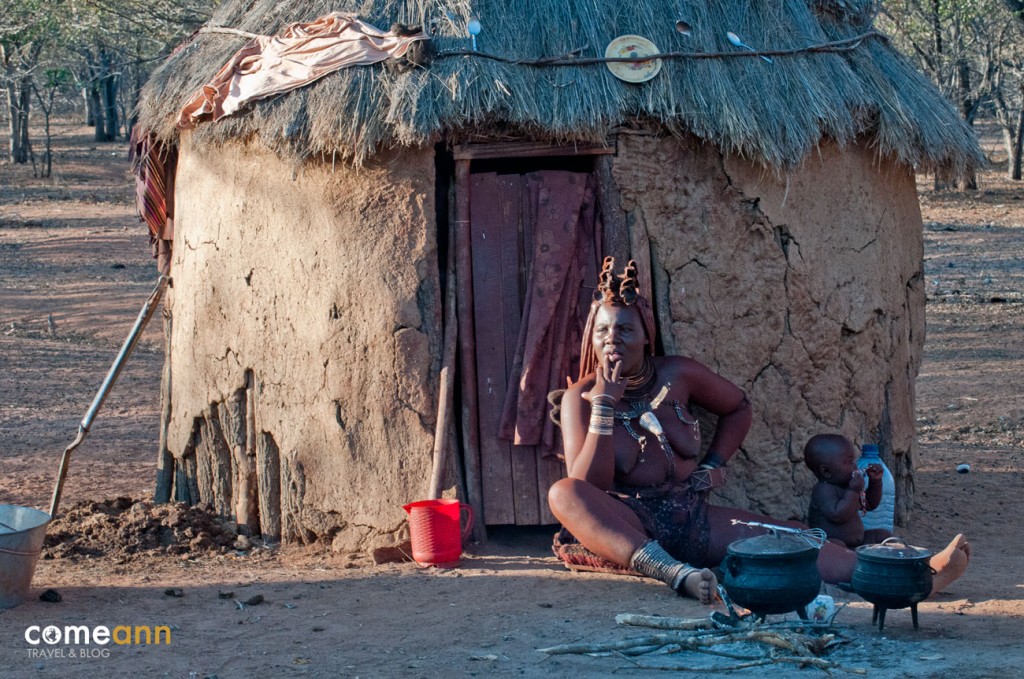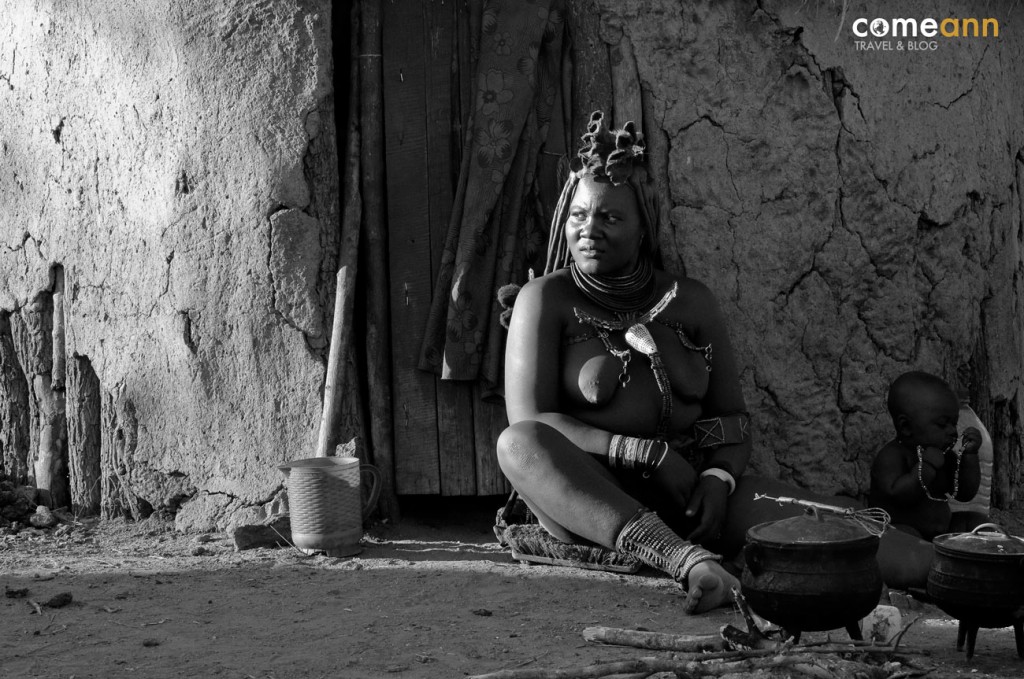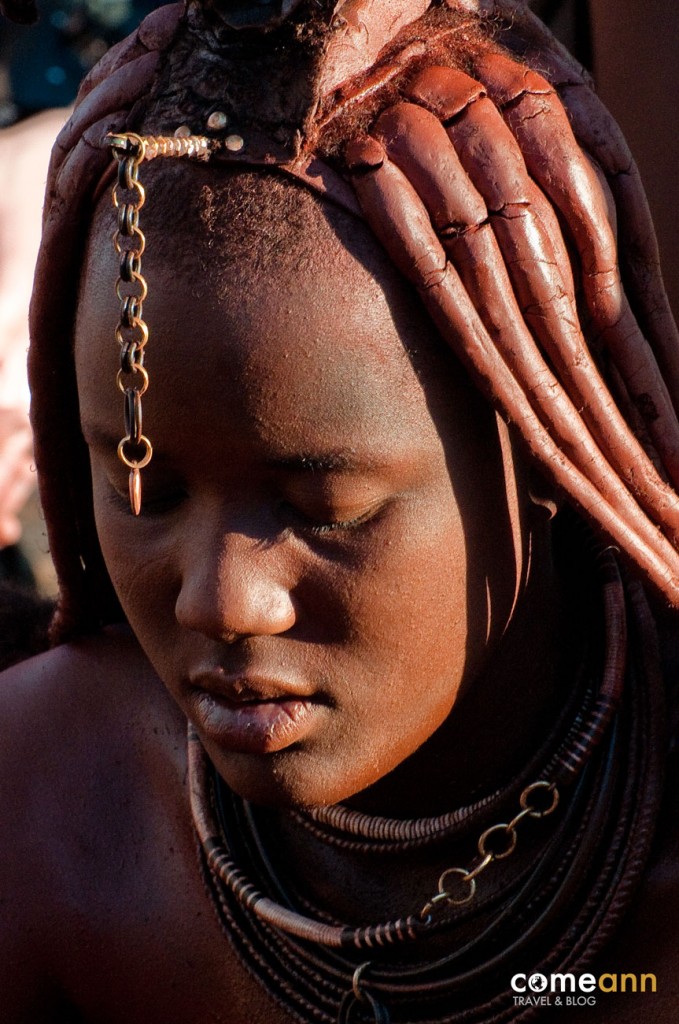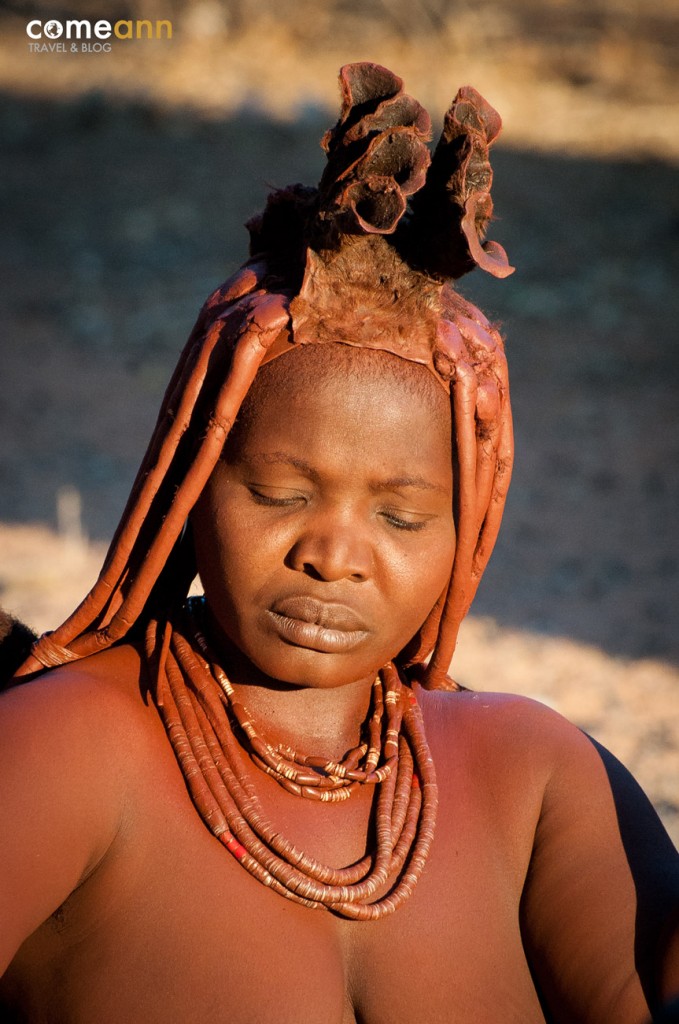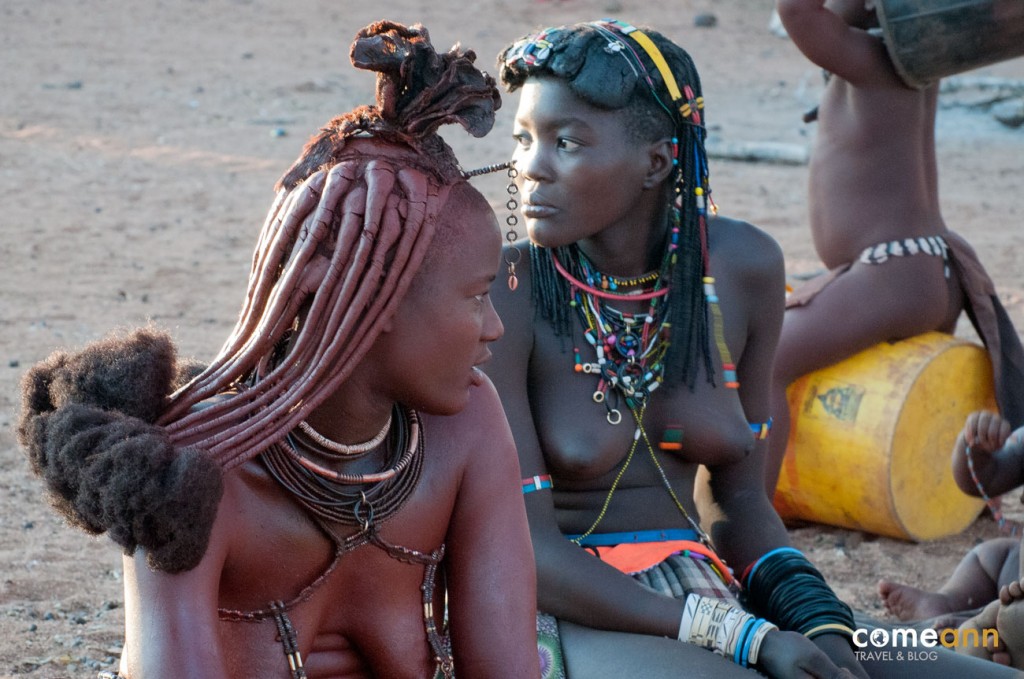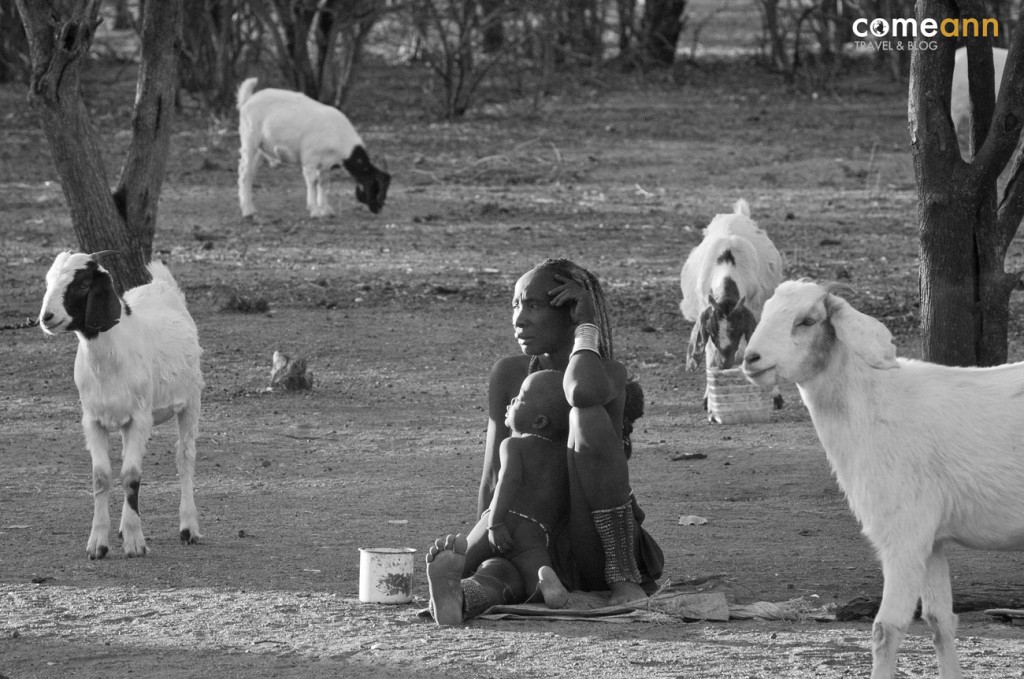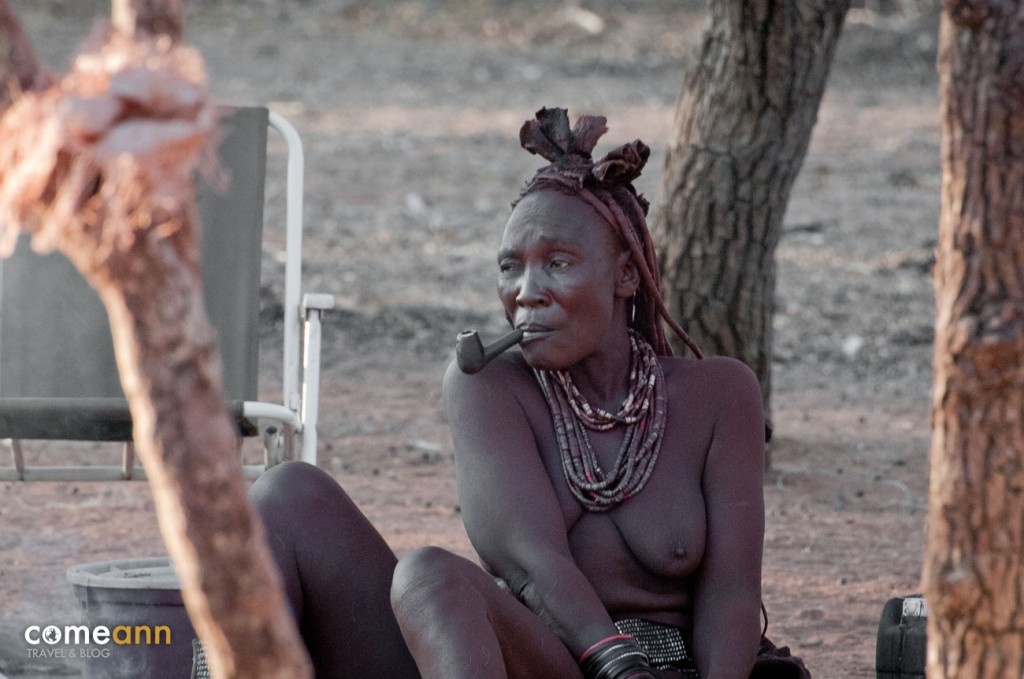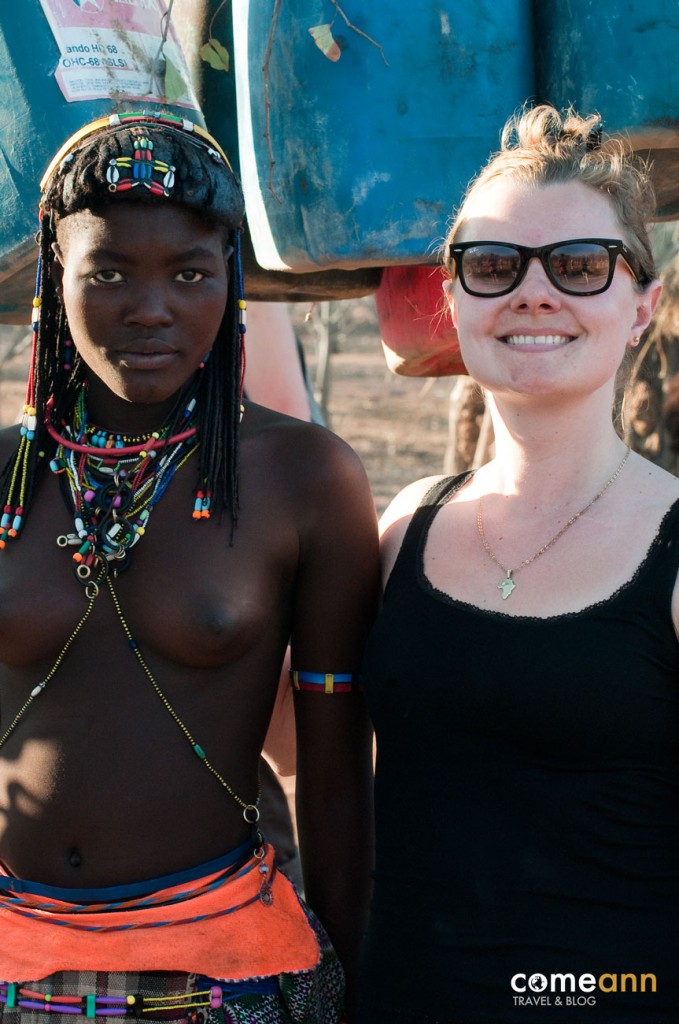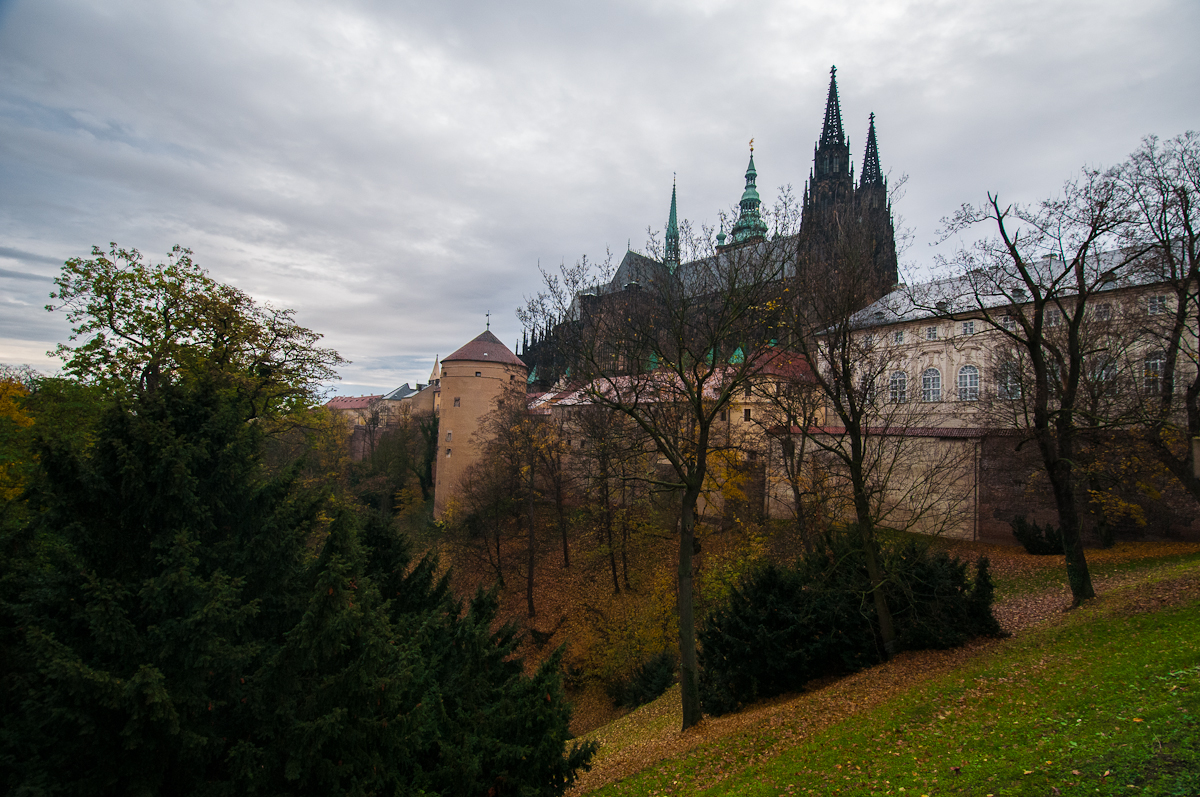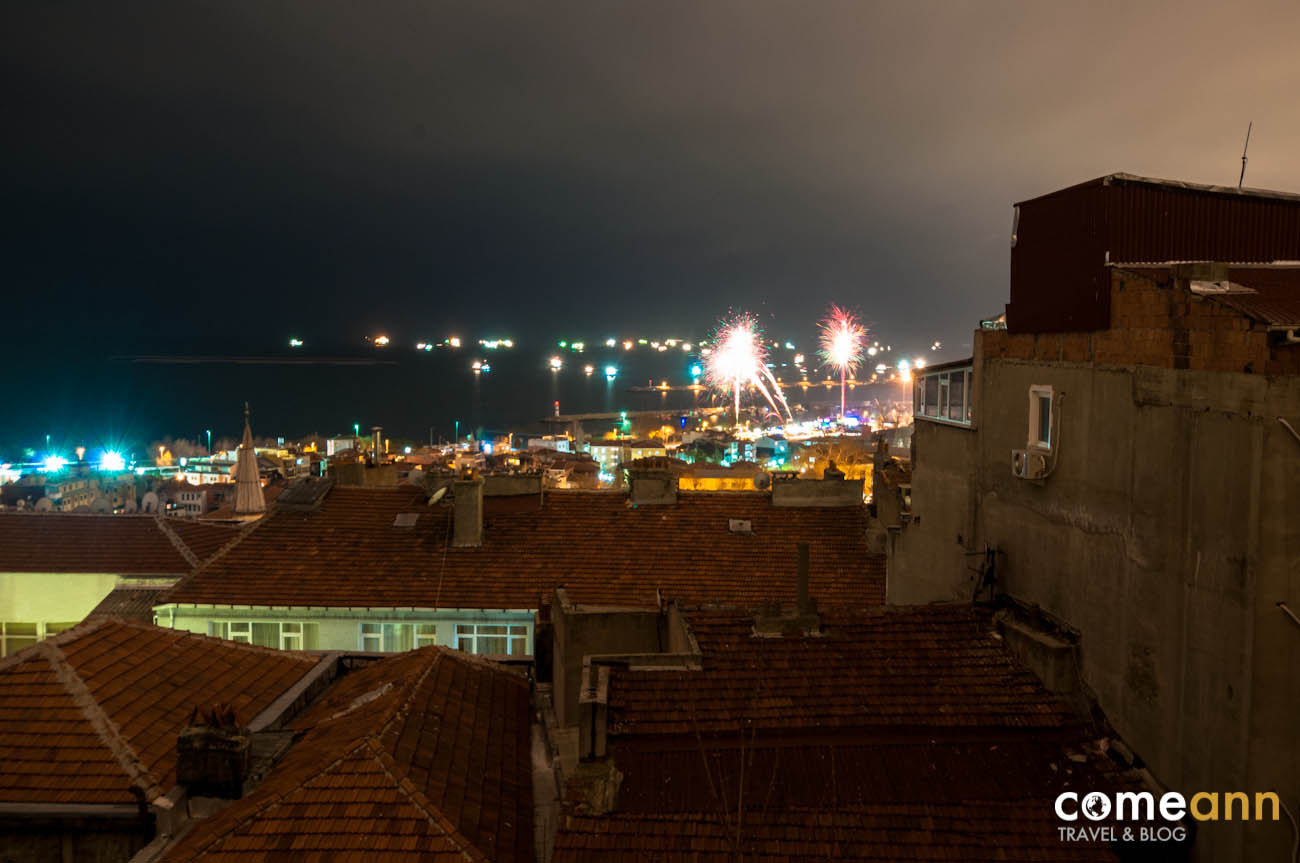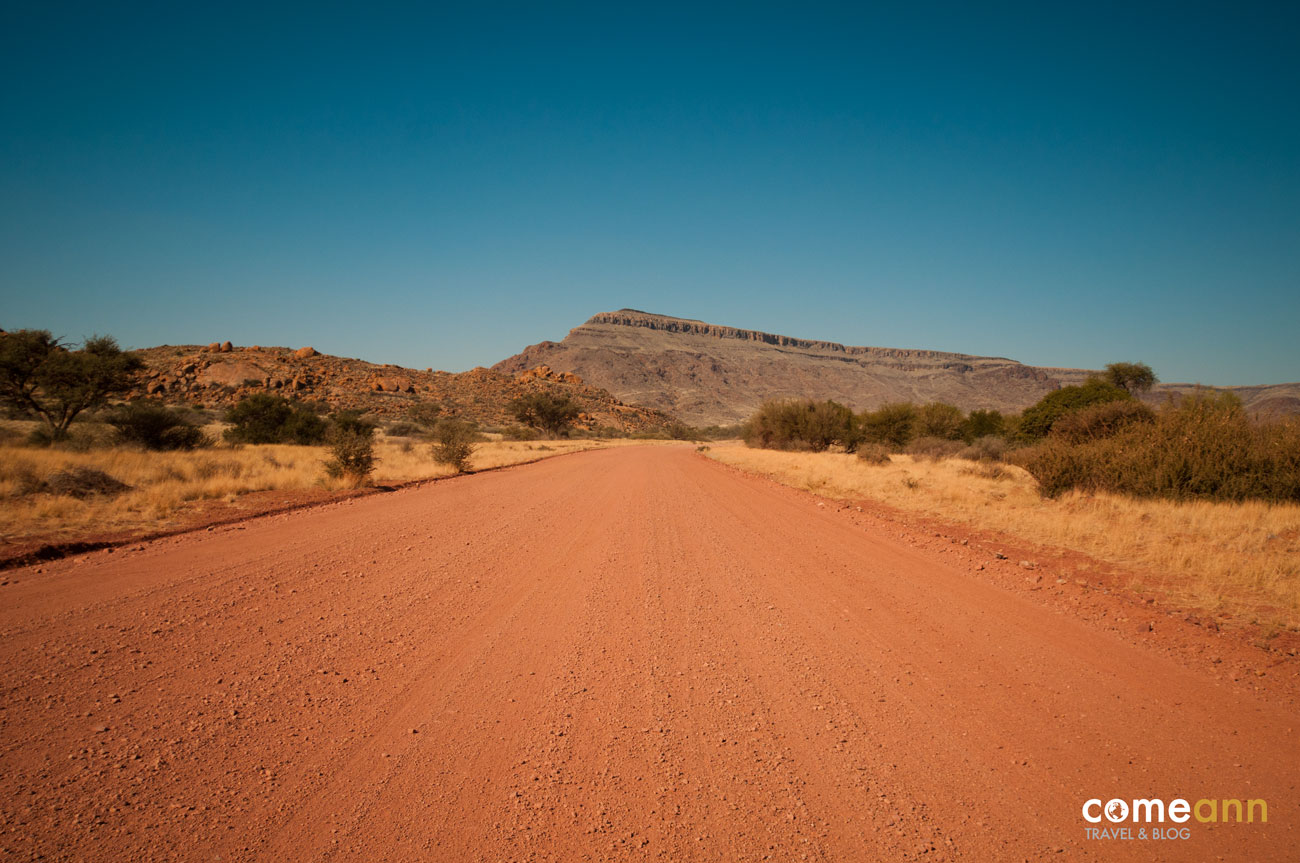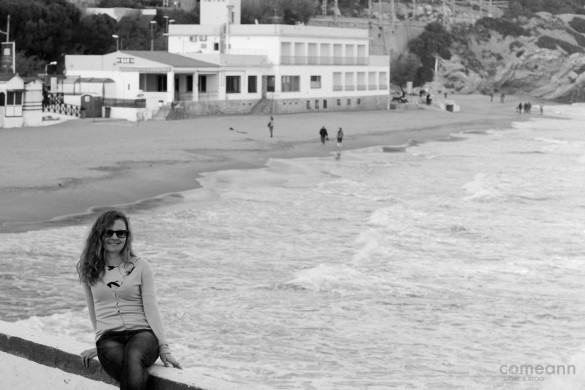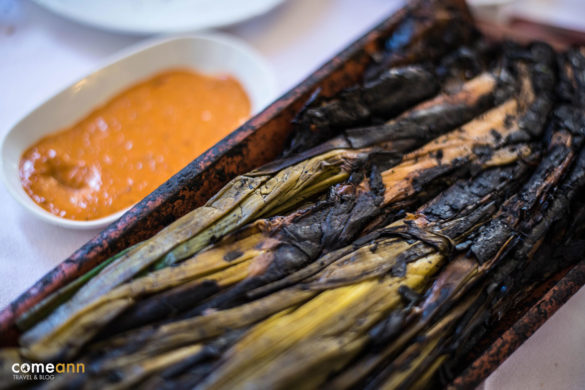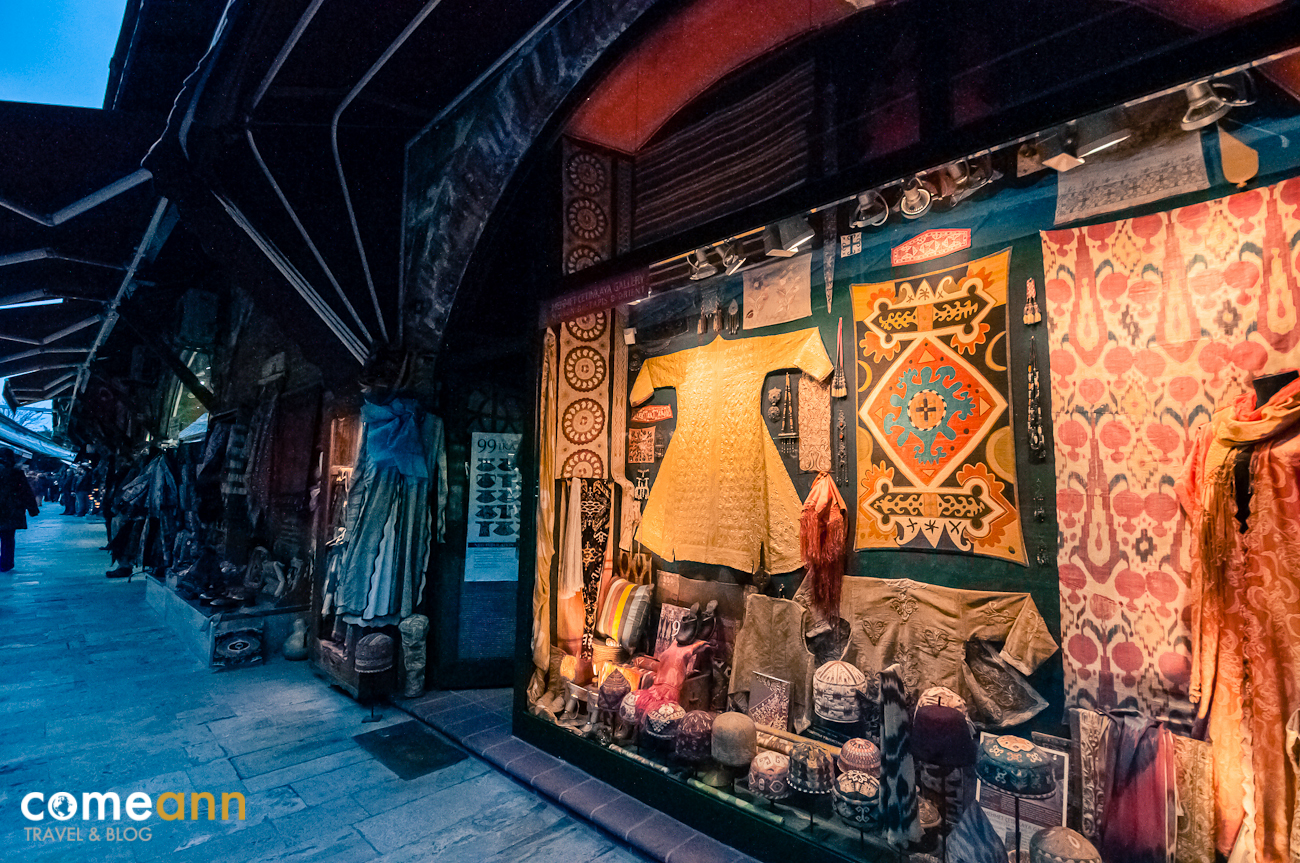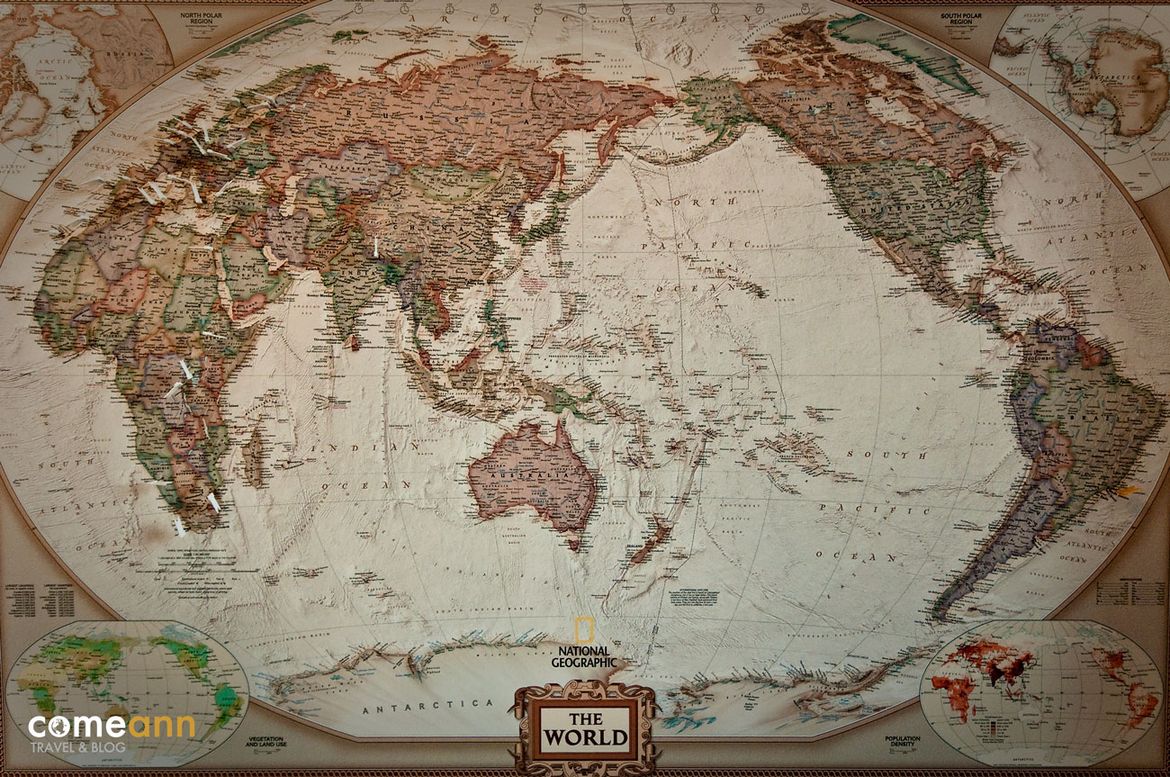Kobiety Himba malują swoje ciała ochrą, a panie z ludu Herero do dziś noszą wiktoriańskie suknie. Mieszkańców Namibii charakteryzuje zupełnie odmienny wygląd, choć wywodzą się z tej samej grupy etnicznej – ludów Bantu zamieszkujących południe Afryki. Podczas mojego wyjazdu miałam okazję ich spotkać i zobaczyć, jak żyją. Były to niezwykłe i bardzo wzruszające chwile. Jednak od początku…
Całkowita ludność w Namibii to niewiele ponad 2,1 mln, a gęstość tutejszego zaludnienia jest jedną z najmniejszych na świecie – na kilometr kwadratowy przypadają zaledwie 2 osoby. Aż trudno to sobie wyobrazić i porównać z ogromnymi aglomeracjami miejskimi i kilkunastopiętrowymi wieżowcami, wyrastającymi w centrum dużych metropolii.
Lud Herero dzieli się na kilka podgrup, między innymi na ovaHimba i ovaTjimba oraz wiele, wiele innych. Niektóre podgrupy mają wspólny język i kulturę, jednak bywa, że ich codzienne tradycje bardzo się od siebie różnią. To rezultat wpływów kolonizatorów na główną grupę Herero, jak również jego brak na inne grupy, takie jak Himba, Kuvale i Tjimba, które pozostały bardziej zachowawcze. Kobiety Herero więc, zamiast tradycyjnej odzieży skórzanej, noszą długie suknie, dokładnie takie, jakie w XIX wieku nosiły żony niemieckich misjonarzy. Widok naprawdę niesamowity!
Herero zaczęli migrować z Afryki Wschodniej na tereny dzisiejszej Namibii w XVII i XVIII wieku. Osiedlali się na trawiastych terenach obecnego Kakoland nad rzeką Kunene i zajmowali się pasterstwem. W XIX wieku zaczęli być wypierani przez lud Nama – doszło nawet do wojny. Wielu Herero przeprawiło się wtedy przez rzekę Kunenę i zaczęło szukać pomocy u buszmeńskiego plemienia Ngambwe w Angoli. Właśnie wtedy, w 1870 roku, nastąpiło rozszczepienie plemienia, a ów lud zaczęto nazywać ovaHimba, czyli „lud żebraczy”. W XIX wieku na tereny Namibii zaczęli wkraczać Europejczycy, a w 1883 roku kupiec Franz Adolf Eduard Lüderitz zawarł umowę z tubylcami. W efekcie powstała niemiecka kolonia zwana Niemiecką Afryką Południowo-Zachodnią. Wkrótce wybuchł konflikt pomiędzy Herero i kolonizatorami. Na początku XX wieku ludy Himba i Herero padły ofiarą eksterminacyjnej polityki prowadzonej przez niemieckie wojska kolonialne. Było to ludobójstwo na ogromną skalę. Szacuje się, że zginęło 75% rdzennych mieszkańców Namibii. Sto lat po tych krwawych wydarzeniach niemiecka minister współpracy gospodarczej Heidemarie Wieczorek-Zeul przeprosiła za zbrodnie w imieniu Niemców i oddała cześć zamordowanym. Jednak wśród Herero pamięć o tamtych wydarzeniach jest wciąż żywa.
To jedynie zarys historii ludności Namibii. Jednak warto go znać, podziwiając bogate suknie kobiet Herero czy mieniącą się na pomarańczowo w afrykańskim słońcu skórę kobiet Himba…
Opuszczam górski rejon Spitzkoppe i jadę na spotkanie z Himba. Mam spędzić w ich wiosce całe popołudnie. Po drodze jednak zatrzymuję się na targowisku, gdzie swoim rękodziełem handlują kobiety Herero. Podziwiam ich niesamowite stroje i twarze pełne dostojeństwa, mimo niewątpliwie trudnego życia i burzliwej przeszłości.
Stroje kobiet są naprawdę wyjątkowe. Europejczycy, którzy przybyli tu w XIX wieku, stwierdzili, że nagość nie przystoi. Stąd też charakterystyczne, bardzo kolorowe suknie „nie z tej epoki”. Kobiety Herero starały się po prostu naśladować styl żon niemieckich misjonarzy. Obecnie jest to już głównie strój ludowy, popularny wśród starszych pań, którego najbardziej charakterystycznymi elementami są: wiktoriańska suknia z krynoliną i kapelusz zwany otjikayiva w kształcie krowich rogów wykonany ze zwiniętych tkanin.
Przypominam sobie legendę o powstaniu ludu Herero, którą przeczytałam jakiś czas temu i która podobno cały czas jest przekazywana z pokolenia na pokolenie. Opowiada ona o drzewie zwanym Omumborombonga (ang. leadwood), rosnącym w wielu rejonach kraju. Według legendy pradawni przodkowie Herero pochodzą od jednego drzewa tego rodzaju i z jednego miejsca, z którego potem porozchodzili się w świat. W czasie swojej drogi byli pod ochroną Boga Mukuru, który udzielił im błogosławieństwa.
Po krótkiej wizycie na targowisku Herero jadę do wioski Himba. Zabieram ze sobą przywiezione z Polski prezenty dla dzieci. Są to głównie przybory do pisania oraz pomoce szkolne, długopisy, flamastry, kredki i trochę słodyczy. Mam nadzieję, że się przydadzą. Do wioski prowadzi nas mieszkanka jednej z chat, która wstępnie opowiada o zwyczajach Himba i o tym, jak powinniśmy się zachowywać. I tak, na przykład powitanie to trzy zwroty wypowiedziane razem – „morro-peribi-nałła”, co oznacza mniej więcej: „Dzień dobry. Jak się masz?”. Do tego koniecznie dochodzi trzykrotny uścisk dłoni.
Himba prowadzą koczowniczy tryb życia. Ze względu na brak lub bardzo ograniczony dostęp do wody, ich głównym zajęciem jest hodowla bydła, które dostarcza im mleka. Kobiety Himba zachwycają oryginalną urodą. Noszą niezwykle fantazyjne fryzury i tradycyjne stroje oraz ozdoby, których waga może ponoć osiągnąć nawet 12 kilogramów!
We wiosce Himba kultywuje się wielożeństwo. Mężczyzna może mieć nieograniczoną liczbę żon pod warunkiem, że pozwoli na to jego status majątkowy, a zgodę na nowe związki wyda starszyzna. Podobno oficjalna stawka to 3 krowy za kobietę… Wioska liczy na ogół około 40 osób. W tej, którą odwiedziłam, było tylko 7 mężczyzn… Zresztą żadnego nie udało mi się zobaczyć. Prawdopodobnie dlatego, że zajmują się oni wypasem zwierząt, więc większość czasu spędzają poza domem.
Kobiety Himba chętnie się witają i pozują do zdjęć, tylko później koniecznie chcą zobaczyć, jak wyglądają na ekranie aparatu. Wywołuje to zawsze liczne komentarze i uśmiechy. Jest bardzo wesoło. Mieszkanki wioski nie kryją zainteresowania naszym życiem. Wypytują nas o rodziny, a przede wszystkim o to, ile mamy dzieci – bycie mężatką to dla nich oczywistość 🙂 Kiedy dowiadują się, że ktoś mieszka sam, są ogromnie zdziwione, kiwają głowami ze współczuciem i mówią coś w swoim języku. W tej kulturze nie istnieje pojęcie „singla”. Kiedy kobieta jest sama, oznacza to najprawdopodobniej, że jej rodzice zmarli lub zostawili ją i nie zadbali, żeby wyszła za mąż. Małżeństwa są bowiem w większości aranżowane.
Mimo to, w kulturze Himba kobiety są obdarzone dużym szacunkiem i zajmują szczególne miejsce w hierarchii. Mają wiele ważnych obowiązków w gospodarstwie domowym. Przygotowują wyprawy pasterskie męża, wychowują dzieci, zajmują się garbieniem skór i robieniem zapasów żywności, wyplatają kosze, rozcierają kukurydzę na mąkę i pracują w polu. Tak naprawdę wykonują większość prac, ale podobno mają też jeden wyjątkowy przywilej, choć nie mówi się o nim głośno. Kiedy męża tygodniami nie ma w domu, bo akurat zajmuje się wypasem bydła, niezaspokojona seksualnie kobieta może bezkarnie oddać się w ramiona jednego z krewnych jej partnera…
Trzeba przyznać, że kobiety Himba są obdarzone nieprzeciętną urodą. Do tego bardzo dbają o swój wygląd zewnętrzny i wszelkie ozdoby. Pokrywają swoje ciało i włosy „otjize” – mieszanką, której głównym składnikiem jest czerwona glinka wydobywana w górach. W skład specyfiku wchodzi także tłuszcz zwierzęcy i różne pachnące zioła. To kosmetyk upiększający i nadający niezwykły koloryt, ale też specyfik chroniący przed słońcem oraz odstraszający insekty. Ochra jest również używana do koloryzacji i pielęgnacji włosów. Fryzura to w ogóle odrębny temat, bo świadczy o statusie społecznym. Małe dziewczynki, do osiągnięcia dojrzałości, noszą warkocze zaplecione z przodu i przykrywające twarz, by nie kusić płci przeciwnej. Kobiety, które są już gotowe do zamążpójścia, wiążą włosy z tyłu głowy sznurkiem z palmy makalani, natomiast mężatki noszą na czubku głowy skórzaną embre – coś jakby czepiec. Wdowy zdejmują embre na znak żałoby. Kobiecy strój na pozór wydaje się bardzo skąpy, gdyż więcej odkrywa niż przykrywa. Tym bardziej zadziwiające jest to, że może ważyć nawet 12 kilogramów!
Warto dodać, że z powodu braku dostępu do wody Himba myją się raz lub kilka razy do roku podczas pory deszczowej. W celach higienicznych okadzają swoje ciała nad ogniskiem, do którego wrzucają specjalne mieszanki pachnących ziół. Podobnie jest z praniem.
Kobiety są bardzo gościnne i życzliwe. Zapraszają nas do swoich chat, w których jest niewiele sprzętu i w ogóle czegokolwiek. Żadnych udogodnień, po prostu klepisko i skóry lub koce służące za łóżka. Kilka garnków, ognisko, kamień służący za blat kuchenny i tyle. Zero telewizji, wi-fi czy kuchenek mikrofalowych. 🙂 I mimo tego, że pewnie mogliby się wynieść do miasta, nie chcą zmieniać swoich tradycji, nie narzekają na trudy życia. Mówią że, starają się cieszyć z tego, że żyją, budzą się kolejnego dnia i są zdrowe. Czy nie jest to najlepsze podsumowanie i coś, co przez jedną chwilę skłoni nas wszystkich do refleksji?
Wizyta u Himba to dla mnie wiele radosnych, ale też wzruszających chwil. Wiele śmiechu z drobnych zdarzeń i rozmów, ale też dłuższe momenty zadumy nad różnicami cywilizacyjnymi i tym, co naprawdę jest w życiu ważne. Myślę sobie teraz, że wiele osób bardzo się dziwi, jak mogę mieszkać w 14-metrowej kawalerce. Zastanawiam się nad tym i odczuwam ogromną radość, kiedy będę mogła wskoczyć pod gorący prysznic, ugotować sobie ciepłą herbatę, czy po prostu napić się wody z kranu. I oczywiste jest, że jesteśmy przyzwyczajeni do innych standardów życia i trudno by było nam w ogóle przetrwać w pierwotnych warunkach. Nie chodzi mi o to, by wywołać w sobie jakieś intensywne uczucia, czy poczucie winy. Wydaje mi się tylko, że zawsze porównujemy się do warunków bardziej luksusowych i nie umiemy docenić tego, co jest tuż pod ręką. A może czasem warto?
•••
Himba women paint their bodies with red ocher and Herero ladies still wear Victorian dresses. The inhabitants of Namibia are characterized by completely different appearance, even though they come from the same ethnic group – Bantu people living in the southern Africa. During my trip I had a chance to meet them and observe their lives. These were extraordinary and very touching moments. Let’s start from the beginning, though…
Total population in Namibia is a bit over 2.1 million and the population density is one of the smallest in the world, only two people per a square kilometer. It’s hard to imagine that and compare to large urban agglomerations and multi-storey skyscrapers sprouting in the centers of big cities.
Herero people are divided into several groups including ovaHimba, ovaTjimba and many, many more. Some of the groups have their own language and culture, however, their everyday traditions may vary a lot. It is for example a result of colonial influence on the main group, Herero, plus the lack of it in the case of other groups, such as Himba, Kuvale and Tjimba, which remain more conservative. So, Herero women wear long dresses, just like the ones that wives of German missionaries used to wear in the XIX century, instead of the traditional leather clothes. This looks really amazing!
Herero started to migrate from the eastern Africa to today’s Namibia in the XVII and XVIII century. They settled on the grassy areas of the current Kakoland at the Kunene riverside and were engaged in pastoralism. In XIX century they were gradually driven out by Nama people and a war began. Many Herero would then get across the Kunene river and seek help from the bushmen tribe Ngambwe in Angola. Then, in 1870, the tribe split and these people started to be called ovaHimba, that is: beggars. In XIX century European people invaded Namibia and in 1883 a trader Franz Adolf Eduard Lüderitz entered into an agreement with the natives. In the end a German colony was set up, called German South-West Africa. Soon afterwards there was a conflict between the Herero and colonizers. In the early twentieth century, the Himba and Herero became victims of extermination policy of the German colonial army. It was genocide on a massive scale, it is estimated that 75% native inhabitants of Namibia were killed. A hundred of years after these bloody events the German Minister for Economic Cooperation Heidemarie Wieczorek-Zeul apologized for the crimes committed in the name of the Germans and honored the murdered. However, among the Herero the memories of those events are still vivid.
This is just a brief history of the population of Namibia. However, it is worth knowing while admiring the rich dresses of Herero women or the skin of Himba women, sparkling with orange in the African sun…
I leave the Spitzkoppe mountain area and go to meet the Himba. I am supposed to spend the whole afternoon in their village. However, on my way I stop on a market place where Herero women sell their handicraft. I admire their amazing dresses and dignified faces, despite their for sure hard lives and the difficult history.
The clothes of the women are truly exceptional. European people who came here in the XIX century found nudity disgraceful. That’s where the characteristic, colorful ancient dresses come from. Herero women simply tried to imitate the style of German missionaries’ wives. Nowadays it is rather a folk costume, popular among elderly women, the most characteristic elements of which are Victorian dress with crinoline and a hat called otjikayiva in the shape of cow horns, made of rolled fabrics.
I recall the legend about the origins of Herero people which I read some time ago and which is still passed from generation to generation. It is a story of a tree called Omumborombonga (leadwood) growing in numerous regions of the country. According to the legend the ancient ancestors of Herero come from such a tree and a one single place from which they spread to the world. On their way they were protected by Mukuru god who gave them his blessing.
After a short visit on Herero market I move on to the Himba village. I take with me gifts for children that I brought from Poland. They are mostly stationery and school supplies, pens, markers, crayons, and some sweets. I hope kids will find them useful. Our guide to the village is a woman living in one of the cottages. She describes the customs of Himba people and tells us how we should behave. For example, a greeting is „morro-pereebee-nawwa” which means more or less „Good morning. How are you?” It must be followed by a triple handshake.
Himba lead a nomadic life. Because of the lack or very limited access to water they are mainly engaged in stock raising from which they can obtain milk. Himba women are distinguished by exceptional beauty. They also have fancy hairstyles and wear traditional dresses and ornaments that can weigh up to 12 kilograms!
In the village polygamy is cultivated too. A man can have unlimited number of wives if only his financial status allows it and if the elder gives permission to the new commitments. Allegedly, the official price is three cows for a woman… In a village live approximately 40 people. In the one I visited only 7 men… I didn’t see any of them anyway. Probably the reason was that they take care about the livestock so they spend most of the time outside of their home.
The women from the village gladly greet and pose to photographs, only afterwards they absolutely want to see how they look like on the camera’s screen. It always brings about numerous comments and laughter. These are moments of joy. Himba are always very curious about our lives. They ask about our families and, first of all, how many children we have – because the fact of having a husband is just obvious. 🙂 When they get to know that someone lives alone, they are very surprised, they nod sympathetically and say something in their language. In this culture a concept of a „single” is non-existent. If a woman lives on her own it must be because her parents died or left her without taking care about her getting married. Most of the marriages are arranged.
Despite this fact, in the culture of Himba women are respected and have a special place in the hierarchy. They are responsible for many important duties in the household. They prepare pastoral expeditions of their husbands, they raise children, tan the skins, stock the food, weave baskets, grind corn into flour and work in the field. Actually they perform most of the work but allegedly they also have one exceptional privilege that is not mentioned aloud. This unwritten rule is that when a husband is away from home for weeks, because he takes care about the cattle in this time, his sexually unsatisfied wife can spend nights with one of his relatives…
It must be admitted that Himba women are exceptionally beautiful. They also take care about their appearance and ornaments. They cover their bodies and hair with „otjize” – a mixture consisting mostly of red clay mined in the mountains. The composition also includes animal fat and a variety of fragrant herbs. Besides the fact that it is a beautifying cosmetic, making the color of the skin very special, it is also a means of sun protection and insect repellent. Ochre is also used for coloring and hair care. Anyway, hairstyle is another topic since it is an evidence of social status. Little girls until maturity wear braids covering their faces so as not to tempt the opposite sex. Women that are ready for marriage bind the hair on the back of their heads with a string of makalani palm tree, whereas married women wear leather embre – a kind of a bonnet. Widows take off their embras as a sign of mourning. The women’s clothing seems very scanty, as it shows more than it covers. Even more amazing is that it can weigh up to 12 kilograms!
It is worth mentioning that because of the lack of access to water, the Himba wash only once or a few times a year. On a regular basis for hygienic reasons they incense their bodies at a fireplace to which they throw special mixtures of fragrant herbs. They also „wash” their clothes this way.
Women are very hospitable and kind, they invite us to their cottages where you cannot find much equipment. No facilities, just a thrashing floor and animal skins or blankets too sleep on. A few pots, a fireplace, a stone serving as a table – that’s all. No television, WiFi or microwaves. 😉 And despite the fact that they could actually move to the city, they do not want to change their traditions, they do not complain about the hardships of life, and as they say, they try to enjoy the fact that they are alive, wake up every day, that they are healthy. Isn’t it the best summing up and something that for a moment makes us reflect upon our own lives?
To me, the visit at Himba was very joyful but also touching. A lot of laughter at minor things and conversations, but also longer whiles of reflection over the civilizational differences and what really matters in your live. I guess many people are now very surprised that I enjoy living in a 14-metres apartment. I think about it and feel very happy that I will have the possibility to take a hot shower, boil water for tea or just take a cup of water from the tap. It is obvious that we are simply accustomed to a different standard of living and we could hardly survive in primitive conditions. It is not about evoking any sense of guilt. I just believe that we always compare our live standard to more luxurious ones and we cannot appreciate what we have. Though maybe we should?


